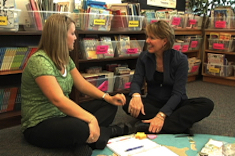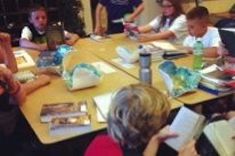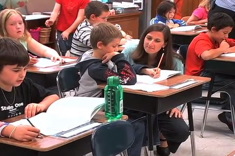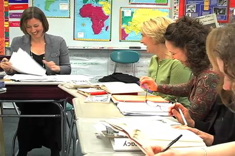As I began working on my schedule for this year, it seemed like I was missing something. Looking it over and thinking about each class, specials, and planning time, I realized what was absent. For the first time in seven years I will not be co-teaching reading with a special educator. For the first time in 12 years, I will not have any special education students in my classroom. While I always look forward to a new challenge, I will miss co-teaching this year. It is something I have grown to love.
When I was first asked to co-teach my reading class with our special education teacher, I had no idea the multitude of issues we would need to tackle. Classroom dynamics, workload, co-teaching styles, and planning were all areas that needed to be addressed. It can be tricky when you are merging two teachers into one classroom, but I found that most problems could be prevented with careful planning.
Finding Time to Plan Together
Time to plan is the first mountain you might need to tackle. Some teachers share common preparation time. I have this with other teachers at my grade level, but not with specialists. To find that critical time, we needed to get creative. We obviously had time available before and after school. But when starting out, we felt like we needed a bigger chunk of time. After meeting with my administrator, we had an answer. She gave us a morning for “administrative leave” once per quarter. By hiring a substitute four half days a year, she invested in our program and we had time to be truly thoughtful about how we would work together.
On our planning days we both would come prepared. We shared calendars with upcoming dates of that quarter and lists of students with their accommodations. We gave careful thought to the needs of each student in our classroom, not just the special education students. We read the standards and the district’s curriculum together, and mapped out a rough sketch of our plans for the entire quarter.
Much discussion would revolve around goals for the grading period. When we looked back at the end of the quarter, what skills did we want each student to have gained? We would then reflect on what that would look like with our regular education students and our special education students. What assistance did we need to have in place to ensure all students in our classroom could succeed?
Organizing for Instruction
Once we had a rough plan in place, we could get down to more detailed lessons. When we first began planning together, we had more discussions about the overall philosophy of the classroom and some explanation of the reading workshop model. With that knowledge in place, we could look at units and the role each of us would play in the delivery of minilessons. We also planned out who would meet with each guided reading group, and which children we would each be responsible for conferring with weekly. We usually alternated the weeks with conferring so that we each met with all students in a two-week span.
While the half day of planning per quarter got long-range plans out of the way, we still needed to meet weekly. Early on we decided to keep these meetings brief. One way we accomplished this was to have a “lead teacher” each week, or each unit, depending on our needs. Some weeks I was the lead teacher, some weeks the special education teacher was the leader. The lead teacher would write out the plans for that week (or that unit) in detail and share them at the weekly meeting, usually after school. That person also gathered the materials for those lessons.
By meeting and looking over the plans, we were able to decide the pacing and how we would deliver the material. I should note that just because one of us wasn’t the lead teacher didn’t mean we weren’t teaching during the minilessons. We always taught together. However, by alternating the detailed planning, each of us had the chance to be “in charge” at certain times. This also helped in the classroom. The students truly felt they had two teachers, not one teacher and an assistant.
Our final “planning” time was more of a period to debrief. We often met for just a few minutes at the end of each class. This gave us time to reflect on the lesson we had just taught and do a quick check-in of what had worked well and what could have gone better. I think this probably helped me grow as an educator more than anything else. I had the opportunity to co-teach with three different special education teachers over the course of seven years. Being able to receive constructive criticism from a colleague who watched me teach every day was an invaluable gift.
Co-teaching is not an easy experience. You have to be willing to meld your teaching style with someone else’s style. I’ve co-taught with teachers who have styles very similar to mine, and with teachers whose styles are very different. What I have gained has been immeasurable. Good communication and time to plan are key elements needed to create a positive co-teaching relationship. With those pieces in place, your classroom will benefit from the experience, care, and knowledge of two committed educators.









